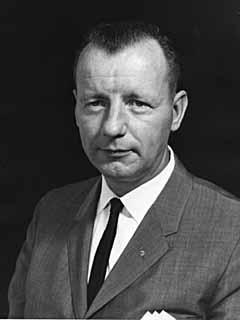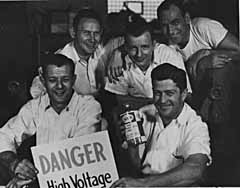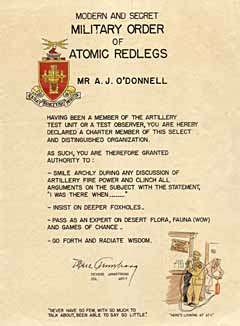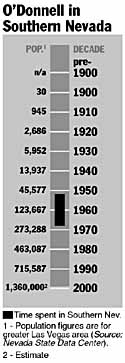Alfred O’Donnell
The U.S.S.R. had just exploded an atomic bomb. Mao Tse-tung's communists had seized power in China. North Korea had invaded South Korea.
Faced with this tumult, in December 1950, President Harry S. Truman authorized a permanent nuclear bomb testing facility in the continental United States. A top-secret feasibility study had examined sites in New Mexico, where the first bomb had been exploded in 1945, as well as sites in Utah, North Carolina, Northern Nevada and Southern Nevada. The last was approved by Truman on Jan. 11, 1951.
In the vanguard of the resulting migration to Las Vegas of well-educated professionals was a young technician named Alfred O'Donnell.
"We brought in the first high-level type of professional people," says O'Donnell, now retired. "Physicists, engineers, doctors. Every type of person you couldn't find in this valley before 1950."
O'Donnell was then a young Bostonian who possessed the rare skill of knowing how to design and build a very complex little gadget that could arm an atomic bomb, start an automated countdown, set it off and collect data on how it behaved. His employers were Drs. Harold Edgerton, Kenneth Germeshausen and Herbert Grier, three scientists who combined their talents and initials to create the firm of EG&G. It was a new company in the new field of energy measurement. Specifically, the energy created when a nuclear weapon exploded.
Following a tour of duty with the U.S. Navy in the South Pacific, and while the war was still under way, O'Donnell, then 23, returned to Boston and was hired by the Raytheon Manufacturing Co.
He was assigned various tasks, but he really didn't understand the purpose of his new job.
"I knew what I was doing, but I didn't know who I was doing it for or what the end game was going to be." And he wouldn't, until he received a high-level security clearance. O'Donnell had unknowingly gone to work for the super top-secret Manhattan Project, developing the very first atomic bomb.
He was still in the dark when Raytheon transferred him to the Massachusetts Institute of Technology, where he first met Edgerton, Germeshausen and Grier.
Later, says O'Donnell, he was conscripted by an electrical engineer named Mike Warchol, who was himself on loan to EG&G from General Electric. Warchol was an expert in the bomb's timing, arming and firing devices, and he shared all he knew with O'Donnell.
"Mike and I put everything together, the prints, the design, the whole thing," says O'Donnell.
In 1947, the president of MIT decided the school would phase out its defense activities.
In a converted Boston garage, EG&G Corp. was born.
"We had 15 employees, including the security guard," O'Donnell recalls.
But business was booming, literally and figuratively. The Truman administration had authorized "Operation Crossroads," a series of tests in the South Pacific on the coral atolls of Bikini and Eniwetok. In all, the Atomic Energy Commission conducted five tests in the Pacific Ocean between 1946 and 1948.
EG&G was charged with designing the equipment to explode the bombs, record their yield, and photograph the results. It was a logistical nightmare.
"You had to set up housing facilities, you had to move equipment out there, you had to move not just scientists, but construction people," says O'Donnell.
As for the scientists and technicians, the extensive traveling involved with Operation Crossroads was tiring and disrupted their home lives.
"With all these (South Pacific) operations, every time I came home, nine months later, we had another child," says O'Donnell, the father of five.
One day in 1952, Grier called O'Donnell and two colleagues, Bill Ward and Bob Morris, into his office and announced that the company planned to open an office and laboratory in Las Vegas, Nev.
"I had heard of Las Vegas, New Mexico," says O'Donnell, who had yet to see the American West.
The men were asked if they would form the vanguard of a force of scientists and technicians who would assist the Atomic Energy Commission in its work at the Nevada Proving Grounds, as the Nevada Test Site was then called.
"And," says O'Donnell, "he told us the company would be forever indebted to us if we could get it off the ground."
Grier chose him, O'Donnell says, because he had become the company's expert on arming, timing and firing devices, and was best able to recruit people who could be easily trained in the new technology.
"We got on the phone and started calling military bases in New Mexico; made trips to San Francisco, doing interviews. We were hiring people on the phone."
The first to join EG&G were six radio technicians employed by Reynolds Electrical Engineering Co. By the end of 1952, they had recruited staff of nearly 50 people. By the time he retired, in 1968, there were more than 8,000 people on the EG&G payroll.
The first EG&G office in Las Vegas was another old garage, this one at 1622 S. A St., now Commerce. The firm later built a facility on Sunset Road, which was demolished for airport expansion.
Las Vegas required some attitude adjustments. O'Donnell recalls being impressed with the great distances, the broad horizons and high mountain ranges.
But standing in the lobby of the El Cortez Hotel, on his first day in town, the young Bostonian found himself quite uncomfortable in the presence of activities that at home were illegal.
"When I looked at those crap tables and slot machines, I got scared," says O'Donnell. "I thought, 'What am I doing in here; I'm going to get arrested.' "
But it was the informality of the Las Vegas, the exact opposite of prim-and-proper Boston, that won him over and made him a lifelong resident. "All of a sudden I discovered that I didn't need a necktie anymore."
Ruth O'Donnell was less impressed. She objected strenuously to all those girlie shows on the Strip. Her husband decided to show her that Las Vegas entertainment was not all flesh and feathers, and promised to take her to a good, funny -- and clean -- show. He had in mind Hank Henry's burlesque revue, then playing at the Silver Slipper.
"I brought her that night and this was the first night they had changed the show from Hank Henry to Tempest Storm, the stripper."
The town's loose moral code sometimes interfered with EG&G's recruiting efforts. Single people, especially men, were usually eager to sign on and move to Las Vegas. Families were less so.
"It was a problem at first," says O'Donnell. On the other hand, he says, the sterling reputations enjoyed by Edgerton, Germeshausen and Grier among scientists, plus the fact that all the research was into largely unexplored areas, was a powerful inducement.
The economic impact of the Nevada Test Site on Las Vegas was substantial, according to Eugene Moehring, UNLV history professor and author of "Resort City in the Sunbelt." He noted that even before the first bomb was exploded in January 1951, Las Vegas was the hub through which all the building materials flowed to the new Camp Mercury, the test site headquarters.
In the first year of testing, the payroll for construction alone was more than $4 million.
In 1952, Truman declared the Las Vegas Valley a "critical defense area." The designation made the valley eligible for more Federal Housing Administration loans, as well as funding for schools, utility improvements and roads.
"In the long run," wrote Moehring, "the valley's designation ... as a critical defense area helped unify local governments behind a public works agenda of systematized improvements which only promoted more growth in the metropolis." He cites figures showing that during the 1950s alone, the population of the city grew from 3,875 to 18,422.
O'Donnell notes that EG&G's move to Las Vegas created a sort of snowball effect among other high-tech firms, who also wanted to involve themselves in the new field of atomic energy. Among those were Holmes & Narver, Raytheon and Bechtel.
While locals arose before dawn to see the awesome blasts, and newspeople from around the world trained their lenses and attention on the mushroom clouds, O'Donnell wasn't that impressed with the spectacles he helped to stage.
"Coming from the Pacific and having seen the tremendous megaton bombs, destroying whole fleets of battleships with one bomb, these out here were like little firecrackers."
Like most NTS veterans, O'Donnell is scornful of those who express doubts about the government's commitment to safety.
"If anybody who was critical of what went on out there were to sit in on the weather briefings, and the logistic briefings among all the heads and brains that come together before we shoot, they wouldn't criticize. If just one thing doesn't meet the criteria to shoot, then nothing happens," he says emphatically.
"Even in the control room, when we get to the point where we're going to start the automatic sequence timer, and the wind factor changes, you stop the shot right there. You don't go any further."
Not that they didn't make mistakes.
Once, says O'Donnell, he sent a new technician into the field to check on the bundle of 56 color-coded wires strung between the control room and the bomb tower several miles away. It was only when he received radio instructions to test a wire of a certain color that he confessed he was color blind.
"I told him to report to the control point to pick up his check," says O'Donnell.
Boredom was an occupational hazard, and it produced some memorable moments for O'Donnell. In the days prior to a test, with all equipment checked and double-checked, there would come a point where there was nothing to do but wait for the atmospheric conditions to become favorable.
Boredom was certainly to blame the day that an unidentified member of O'Donnell's crew slipped out the door and returned a while later at the helm of a large crane. Grier's new Fiat was then hoisted onto the roof of the building where he was working.
The hubbub caused by that prank, however, was nothing compared to The Great Doom Town Caper.
In 1951, the AEC scheduled a special shot called "Annie," which was aimed at determining how a typical American town would withstand a direct hit by a nuclear bomb. Numerous federal dignitaries were invited to tour the site, and witness the demise of "Doom Town."
Homes were constructed of various materials, complete in every detail, with a car in every garage. New furniture was purchased, current magazines were laid on coffee tables, and larders were stocked with fresh foods flown in from San Francisco. The inhabitants were mannequins of the type found in department stores.
O'Donnell and two other men, Bernard Murphy and Ed Tucker, had finished their jobs, were bored, and decided to have a look at the finished town.
"Because of the type of clearance we had, we could go anywhere on the test site; we could go up in the tower and sit on the bomb and eat our lunch if we wanted to," says O'Donnell. As they walked through the houses, it struck them that the mannequins were not as lifelike as they could be. It was, after all evening, time to retire.
"So we took Pa out of his rocking chair, and took Ma from the kitchen sink and we took them upstairs to the bedrooms."
When the Washington bigwigs arrived to see how tax dollars were being used, they discovered houses full of dummies engaged, as O'Donnell politely puts it, "in compromising positions."
"The repercussions from that were terrible," O'Donnell laughs. "Nobody knew who did it, of course, and I'll deny it ever happened."
Part I: The Early Years
Part II: Resort Rising
Part III: A City In Full




















